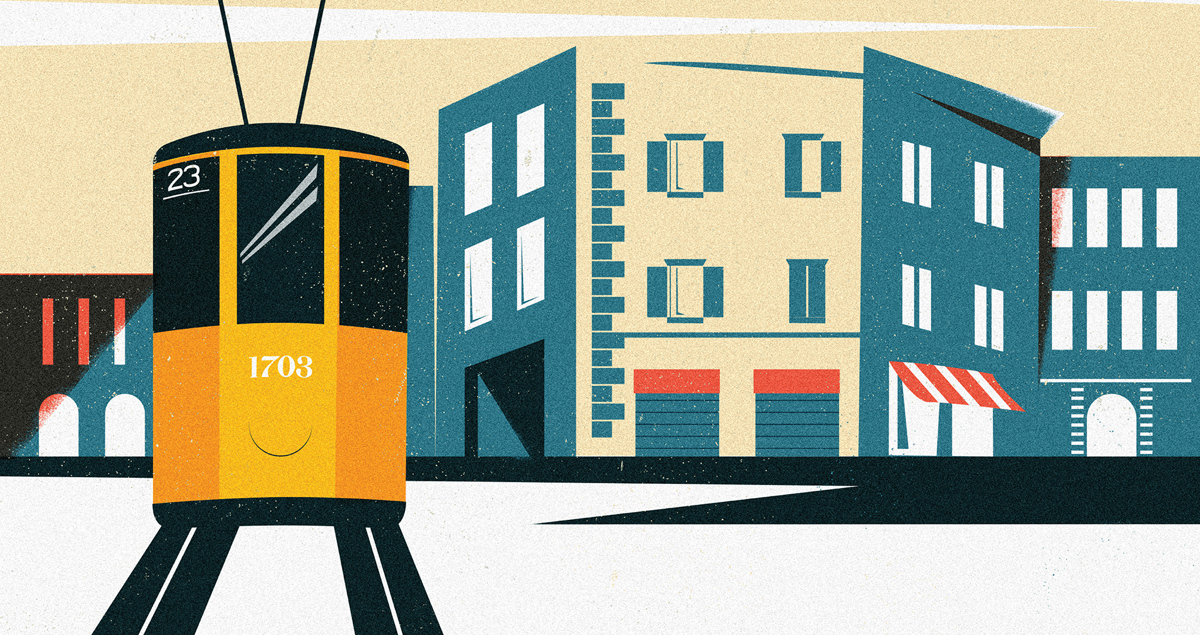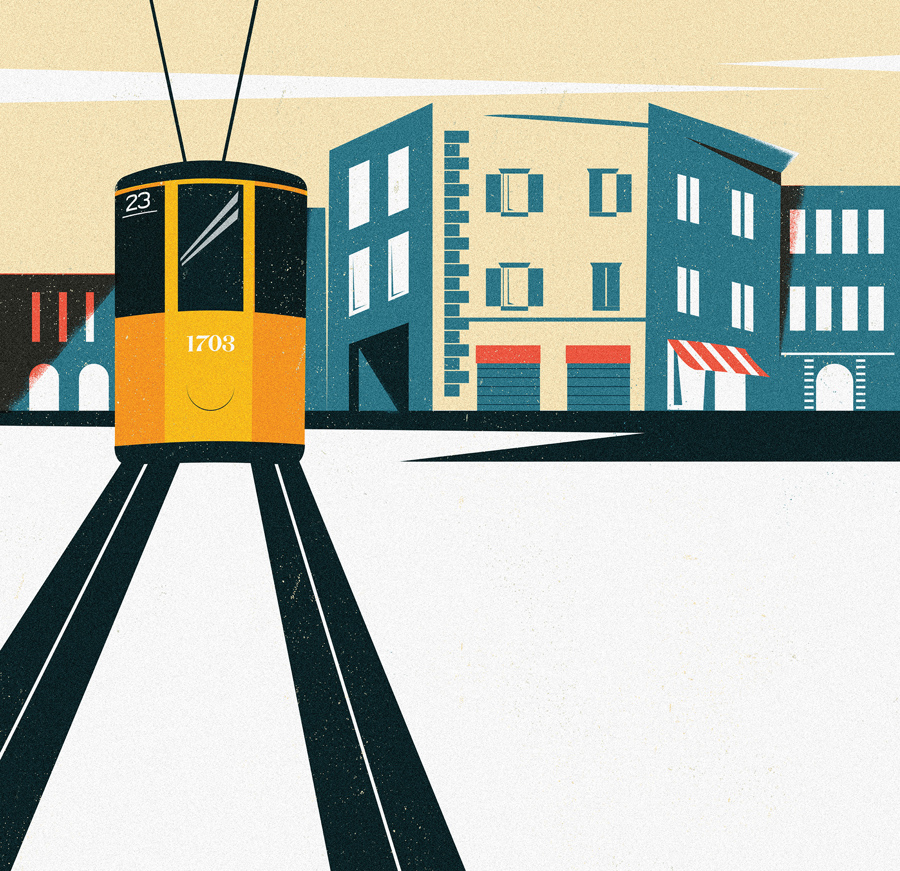
Milan
« Ogni giorno Milan esce fuori di man/Crescendo va diventa ’sta città/Slarga fuori di qua sbatti fuori di là/Ti tiran su ti sfondan giù Milan » [« Chaque jour Milan nous glisse entre les doigts/Elle grossit et devient cette cité/Qui s’étend par-ci, qui se répand par-là/Ça t’élève bien haut, ça te brise en deux Milan »] Stramilano S.T.R.A.M.I.L.A.N.O. Elle est bien décrite, dans les paroles de cette chanson populaire, l’impossibilité de contenir une ville comme Milan, qui a toujours été déchirée entre son présent et son avenir. Au cœur même de son nom antique, Mediolanum, on retrouvait déjà son âme et son destin métissés, puisqu’il s’agit d’un mot celte (Medioplanum) qui nous est parvenu sous cette forme par le biais des écrivains latins (avec un p en moins). Au sens littéral, ça signifie, « au milieu de la plaine » ou « plaine du milieu ». Et c’est précisément la géolocalisation de ce mot qui rend si évidente la position centrale de Milan en plein centre d’une ancienne plaine alluviale. L’âme marine de la ville a toujours été soulignée par la présence des navigli [canaux]. Et Milan, à cause sa centralité, a toujours été considérée, voie définie, comme la Gran Milan [Grande Milan], la ville qui coupe le souffle de celles et ceux qui la visitent, leur faisant s’exclamer : « Milan es peu pu » [« Milan et rien d’autre »]. D’un autre côté, Milan a toujours aimé les monuments géants : La Scala, le Simplon, le Duomo, la Galleria. Sans parler de son génie scientifique, comme le rappelle Emilio De Marchi : « I tram, la lûs elèttrica, l’ospedaa… I forestee che vègnen de lontan, veduu Milan, conten cent meravili di noster micchett, del noster paneton e della confusion che se mœuv per i strad e della gent rotonda e lustra che va attorna. » [« Le tramway, les ampoules électriques, l’hôpital… ces étrangers qui viennent de partout pour visiter Milan décrivent les merveilles que sont la michette et le panettone, l’effervescence des rues et la populace fière et bien nourrie qui va et vient. »] À Milan, on peut manger une michette (type de pain brioché qu’on reconnaît à son moule en étoile avec un chapeau au centre), un panettone (pain sucré italien proche du gâteau aux fruits, originaire de Milan, qu’on prépare et déguste surtout à Noël), une cotelette (de veau, de porc, d’agneau), un ossobucco (moelle) avec un risotto. Et son âme aussi magique qu’impénétrable est bien représentée par le scighera, cet épais brouillard qui l’envahit depuis tant d’années. Le scighera, c’est la saveur, l’esprit, l’ambiance de cette ville. À Milan on retrouvait les Sforzas, mais aussi Leonardo, Verdi, Toscanini, on retrouvait même des dragons. C’est la ville de la mode, des maisons d’édition, des maisons de disque, la ville de la publicité, de la télévision. C’est aussi l’endroit dont l’esprit se traduit dans la langue milanaise, chantée par Gufi, Svampa, Jannaci, Cochi et Renato. Milan, c’est toutes ces choses qui vivent et s’étendent sur la plaine où elle fut fondée. Milan, c’est le son clair, rectiligne, écologique et électrique des trams qui la traversent de bord en bord. Milan, c’est l’émerveillement qu’on ressent à la contempler du haut du Duomo, aux côtés de sa Madonnina.
Luca Crovi

« Ogni giorno Milan esce fuori di man/ Crescendo va diventa ‘sta città/Slarga fuori di qua sbatti fuori di là/ Ti tiran su ti sfondan giù Milan/ Stramilano S.T.R.A.M.I.L.A.N.O. » Nei versi di questa canzone popolare è ben descritta l’impossibilità di contenere una città come Milano che per tutta sua vita è sempre stata in corsa fra il suo presente e il suo futuro. Anche il suo toponimo Mediolanum ne mostra già l’anima meticcia e il destino, visto che è una parola celtica (Medioplanum) che in questa forma è stata tramandata dagli scrittori latini (con la p caduta). Significa letteralmente « in mezzo alla pianura » o « pianura di mezzo ». Ed è proprio la geolocalizzazione di quella parola a chiarirci che Milano ha una posizione centrale nel mezzo di un’antica pianura alluvionale. L’anima d’acqua della città è sempre stata sottolineata dalla presenza dei Navigli. E Milano proprio nel suo essere centrale è stata sempre guardata e definita come la Gran Milan, Una città capace di togliere il fiato e di far dire a chi l’ha visitata: Milan es peu pu (Milano e poi più niente). D’altro canto Milano ha sempre giganteggiato nei suoi monumenti: la Scala, il Sempione, il Duomo, la Galleria ma anche nelle sue evoluzioni scientifiche come racconta Emilio De Marchi: « I tram, la lûs elèttrica, l’ospedaa... I forestee che vègnen de lontan, veduu Milan, conten cent meravili di noster micchett, del noster paneton e della confusion che se mœuv per i strad e della gent rotonda e lustra che va attorna ». [I tram, la luce elettrica, l’ospedale… gli stranieri che vengono da lontano, vista Milano, raccontano cento meraviglie delle nostre michette, del nostro panettone e della confusione che si muove per le strade e della gente rotonda e orgogliosa che se ne va in giro.] A Milano si possono mangiare le michette, il panettone, le cotolette, l’ossobuco col risotto. E la sua anima magica è impenetrabile è rappresenta dalla scighera, quella nebbia spessa che l’ha invasa per anni. La scighera è il suo sapore, il pensiero, l’umore della città. A Milano ci sono stati gli Sforza ma anche Leonardo, Verdi, Toscanini e persino i draghi. È la città della moda, delle case editrici, delle case discografiche, della pubblicità, della televisione. E il luogo dove la lingua che ne esprime lo spirito è il milanese e a usarlo nelle canzoni sono i Gufi, Svampa, Jannacci, Cochi e Renato. Milano è tante cose che tutte si adagiano e allungano sulla pianura dove è situata. Milano è il suono pulito, lineare, ecologico ed elettrico dei tram che l’attraversano. Milano è la meraviglia di guardarla dalla cima del Duomo accanto alla sua Madonnina.
Luca Crovi
“Ogni giorno Milan esce fuori di man/ Crescendo va diventa ‘sta città/Slarga fuori di qua sbatti fuori di là/ Ti tiran su ti sfondan giù Milan” [Every day Milan slips through our fingers/ It grows, becoming this city/ That stretches out in all directions/ Milan gets pulled up and broken apart] Stramilano S.T.R.A.M.I.L.A.N.O. The lyrics of this pop song aptly describe the impossibility of containing a city like Milan, which has always been torn between its present and its future. Even its ancient name, Mediolanum, reflects this multifaceted identity, since it comes from a Celtic word (Medioplanum) that was handed down by Latin writers, losing a p in the process. It literally means “in the middle of the plain” or “middle plain.” And the geolocation of that word makes it clear that Milan occupies a central position in the middle of an ancient alluvial plain. The city has an obvious connection to water, evident in its system of interconnected canals or navigli. And because of its central location, Milan has always been defined by its greatness; “Gran Milan,” a city that takes your breath away and prompts visitors to exclaim, Milan e poeu pu! (Nothing beats Milan).
Milan has always loved its outsized monuments such as La Scala, the Simplon, the Duomo, the Galleria, not to mention its works of scientific genius, as Emilio De Marchi writes: “I tram, la lûs elèttrica, l’ospedaa... I forestee che vègnen de lontan, veduu Milan, conten cent meravili di noster micchett, del noster paneton e della confusion che se mœuv per i strad e della gent rotonda e lustra che va attorna.” [The trams, the electric light, the hospital… the foreigners coming from afar to visit Milan tell of the wonders of our michette and panettone, the hustle and bustle in the streets and the proud, well-fed people wandering around.] In Milan, you can eat michette (a type of brioche in a signature star shape with a central “hat”), panettone (an Italian sweet bread similar to fruitcake, originally from Milan, usually prepared and enjoyed at Christmas time), cotolette (veal, pork or lamb chop) and ossobuco (marrowbone) with risotto. And the city’s magical, impenetrable soul is perfectly embodied by the scighera, a thick mist that has settled over its streets for years. The scighera gives Milan its flavour, its spirit, its atmosphere. The Sforzas were based in Milan, also known for Leonardo, Verdi, Toscanini and even dragons. It is the city of fashion, of publishing houses, of record labels, of advertising, of television. It’s also the home of the Milanese dialect, sung by the likes of Gufi, Svampa, Jannacci, Cochi and Renato. Milan is all the things that coexist on the great plain where it was founded. Milan is the crisp, straight eco-responsible sound of the electric streetcars that cross it daily. Milan is the rush of wonder you feel when you look down at the city from the top of the Duomo, just beside the Madonnina.
Luca Crovi
